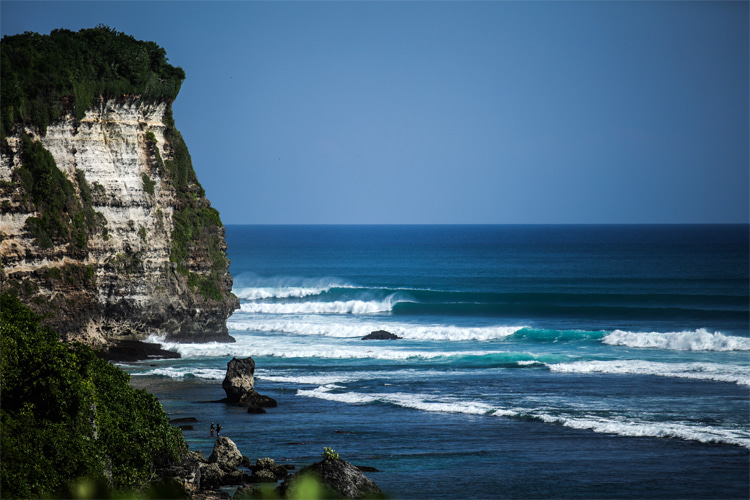Uluwatu is a world-class left-hand point break located on the southwestern tip of the Bukit Peninsula in Bali, Indonesia.
The surf spot consists of a series of peaks that break in front of an imposing limestone cliff, offering several different wave-riding experiences.
The secret of Uluwatu waves is the deep-water channels on both sides of the Bukit Peninsula that drive swell onto the reefs spread along the coastline.
The area handles all swell sizes and directions well, with each peak behaving individually at different tides.
Nevertheless, the rule of thumb here is - the higher the tide, the more mellow and slower the wave becomes.
As a result, low tide is often regarded as the perfect moment for intermediate and advancer riders, and high tide is the ideal time for beginners.
Uluwatu means "the land's end stone."
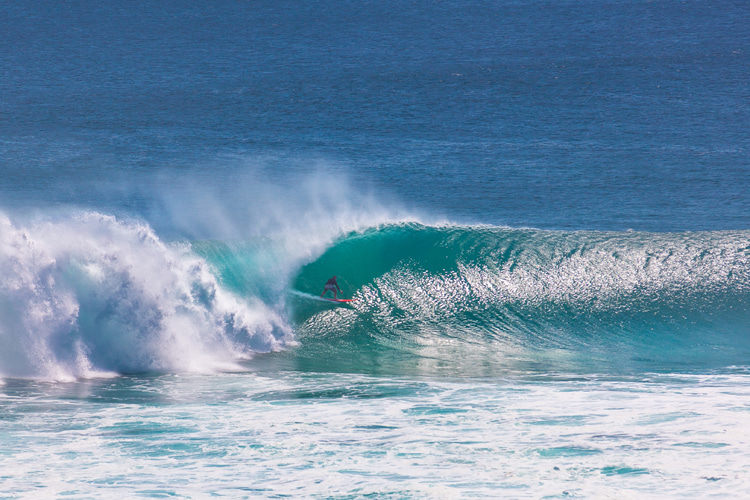
The History of Uluwatu
The history of surfing in Uluwatu is relatively recent.
The collection of five outstanding waves separated by 100 yards was unexpectedly unveiled by foreign traveling surfers.
"While Uluwatu may have been surfed in the late 1960s by visiting American and Australian GIs, its well-documented 'discovery' took place in August 1971, when Aussie surf moviemaker Alby Falzon arrived with 14-year-old Steve Cooney of Sydney and former top-rated California surfer Rusty Miller," explains Matt Warshaw in "The Encyclopedia of Surfing."
"Falzon filmed the two riding perfect four-to-eight-foot The Peak and Racetracks waves for his seminal 'Morning of the Earth' surf film."
Interestingly, Alby Falzon's original goal was to shoot surfing in Kuta Beach. However, his team eventually discovered another wave down the local Pura Luhur Uluwatu temple.
Cooney might have been the first to ride Uluwatu, and the moment was featured on "Morning of the Earth."
After being released in 1972, the movie changed life in and around Uluwatu forever, making it one of the most sought-after waves on the planet.
Several facilities were built and opened in the surrounding area to greet surfers from all corners of the Earth - surf camps, bars, hotels, cafés, restaurants, surf shops, condos, and stores.
"By the mid-1970s, local Balinese surfers including Ketut Menda, Made Kasim, and Gede Narmada had joined well-known visitors such as Gerry Lopez, Peter McCabe, and Jim Banks in Uluwatu's aquamarine lineup, and photos of the break were a regular feature in surf magazines."
Uluwatu is one of the best surf spots in the world, but it can also be a challenging wave.
In 1972, California surfer Bob Laverty lost his life surfing Uluwatu.
He had just led the first surfing expedition to Java's Grajagan when he drowned in the Balinese surf break.
The first surf competition held at Uluwatu was the 1980 OM Bali Pro, an event won by Terry Fitzgerald.
Uluwatu has been featured in several surf movies, including "Free Ride" (1977), "Bali High" (1981), "The Sons of Fun" (1993), "Year of the Tiger" (1999), and "Ulu 32" (2003).
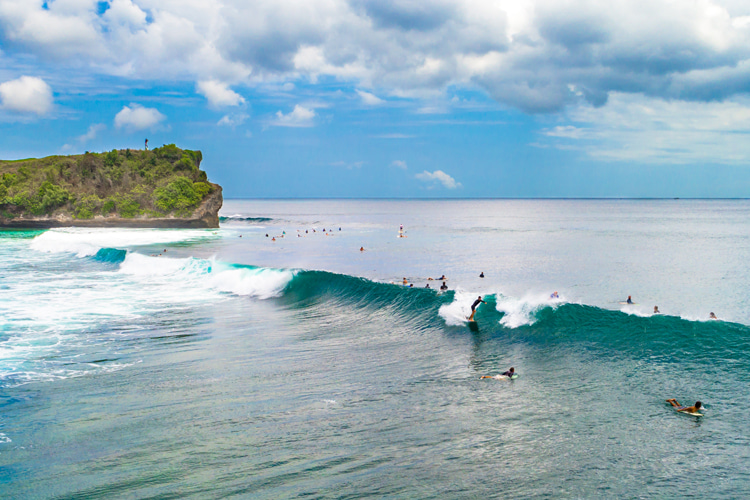
Bukit Peninsula: A Swell Magnet
Uluwatu is a highly consistent surf spot due to its geographical location and openness to all Indian Ocean swells.
Thanks to its wide reef that spreads across the whole break, it produces different types of waves throughout its multiple peaks.
Indonesia's crown wave is often crowded and requires a lot of patience, especially from foreign surfers.
Paying attention to the shallow reef and the currents is mandatory.
The best time of the year to surf Uluwatu is from May to October, when Indian Ocean winter storms generate consistent four-to-ten-foot-plus swells.
As they reach the Balinese coastline, wave trains meet southeast tradewinds, creating some of the finest surfing waves in the world.
Large swells should be surfed on low tides, while small and medium swells can be ridden on all tides.
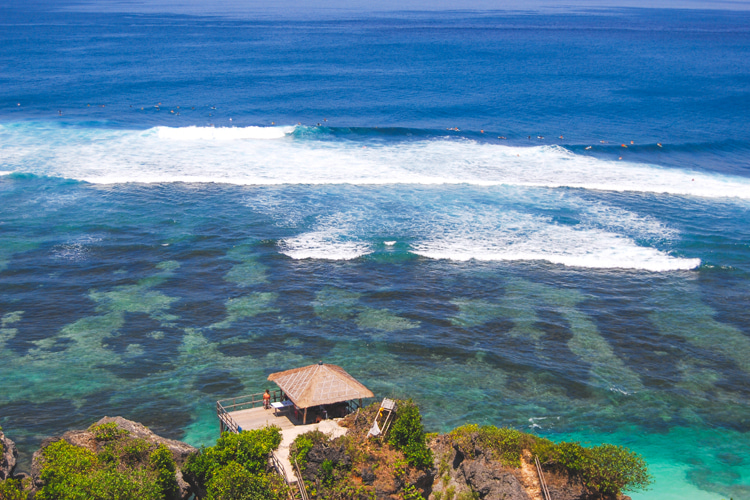
Five World-Class Waves
Uluwatu is more than just a wave - it's a collection of five pristine peaks and a paradise playground for goofy footers. They are:
1. The Bombie
It is the most exposed Uluwatu wave to sizeable open ocean swells. On an epic day, it can produce one of the biggest waves in Indonesia.
When deeper water hits the reef, it jacks up and creates a challenging 20-to-30-foot liquid wall that will peel for up to 1.2 miles (two kilometers) and eventually link to Outside Corner.
The Bombie is home to some of the heaviest hold-downs in Asia. People have lost their lives surfing this wave, so bring jet ski support, paramedics, and a gun or tow-in board.
2. Temples
It is the southernmost surfing peak and the least crowded section of all Uluwatu waves.
It requires a long paddle from Blue Point Beach to get to the take-off zone, but it could be a good option on small swell days. Nevertheless, expect a heavy wave that breaks fast on shallow water.
Position yourself below the old temple on the cliff above, and you'll get what you wanted - long and hollow walls of water with several tube-riding opportunities on high tide.
3. Outside Corner
It's one of the most popular Uluwatu peaks and begins to work best at low tide with a solid swell. Outside Corner is one of the most famous waves in Indonesia and a spot for advanced surfers.
Its big open faces invite riders for high-performance maneuvers at high speed.
The outer reef shines to life with six-to-eight-foot swells, creating huge 12-to-15-foot cylinders of water and forcing adventurers to drop into steep walls of water.
With the right conditions, you can connect to Racetracks and The Peak, meaning a 300-yard-long ride. The wave is visible south of Blue Point Beach from the clifftop south.
4. Racetracks
It is the first Uluwatu peak you see after exiting the cave and the last left-hander on offer at this particular reef.
It's an incredibly fast, hollow, barreling wave that gets especially dangerous in low tide. At mid-tide, you might be safer but still enjoying decent tubes.
The take-off zone is right of the cave, and it peels perfectly past the corner of the cliff face toward Padang Padang. Make sure to fine-tune your positioning so that you can experience it.
It looks like a surfing machine that offers a long ride of up to 350 yards on a good day. For many, it's the fastest of all five Ulu peaks. Beware of the shallow reef.
5. The Peak
It is the first wave you see in front of you coming out of the cave. It is often Uluwatu's entry and exit point.
The Peak is the most consistent spot of all five waves and features several take-off zones, depending on the swell angle.
The take-off provides short yet intense hollow barrels that should be ridden on high tide. This place is always pumping waves, but make sure to kick out when you get near the rocks at the end.
It is one of the most crowded Ulu waves.
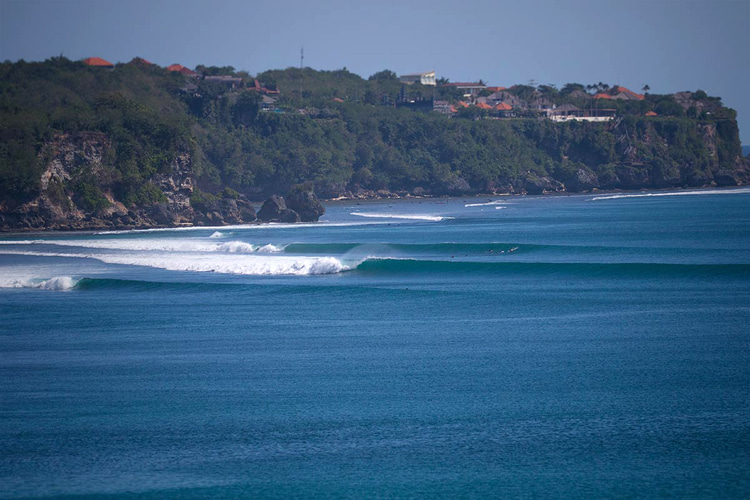
Getting In and Out of the Water
Access to the Balinese surfing paradise requires knowledge of the area.
If you're about to paddle out for the first time, climb down the stairs of the local cliff, and exit the famous cave that leads directly to the water on high tide.
If it's low tide, you'll need to walk 100 yards across the shallow and sharp reef to get to the lineup.
Make sure to dodge the current that will put you in the way of surfers riding Racetracks and drag over unwanted corals.
An alternative could be turning left at the bottom of the Uluwatu staircase and through a small cave that will lead you to Suluban Beach.
Then, if you walk further down, you can paddle out easily toward Temples.
To exit the surf, you should not get back to terra firma through the cave, especially on high tide.
Timing the entry into the cave with so much backwash and water moving around could be tricky and dangerous.
If you miss the cave, get ready for another 15-minute paddle around.
The trick is to negotiate your exit up the reef to avoid getting pounded. Alternatively, paddle toward Padang Padang and walk back to Uluwatu.
Wearing booties will protect your feet against the sharp coral reef, and use a strong leash.
Monkeys and lizards are everywhere - don't be scared, but try not to provoke them.
Uluwatu, Bukit Peninsula, Bali, Indonesia | ID and X-Ray
Location: Bukit Peninsula, Bali
Type of Wave: Left-Hand Point Break
Length: Up to 1.2 Miles (two kilometers)
Best Swell Direction: S-SW
Best Wave Size: 5-18 Feet
Best Wind Direction: S, SE, E, NE, and N
Best Tide: All Tides
Best Time to Surf: May-October
Skill Level: Intermediate to Advanced
Best Board: Shortboard, Fish, and Gun
Crowd: Mostly Crowded
Water Quality: Mostly Good
Hazards: Sharp Reef, Localism, Currents
Bottom: Shallow and Sharp Coral
Water Temperature: 77-86 °F (25-30 °C)
Getting There: Walk and Paddle
